
Dental Implant Horror Stories
When it comes to general dentistry, if something goes wrong, you might end up losing a tooth. However, when things go wrong with dental implants, the health of your entire body is at risk. Dental implantology involves both a restorative and a surgical aspect. Some dentists rely heavily on an oral surgeon to assist them with creating the final treatment plan for their dental implant patients. Unfortunately, this can often become problematic because oral surgeons are typically less knowledgeable about the restorative side of dentistry. A periodontist has an understanding of both the restorative and surgical sides of dental implants, which allows him to more effectively lay out a specific and accurate treatment plan for the oral surgeons he works with.
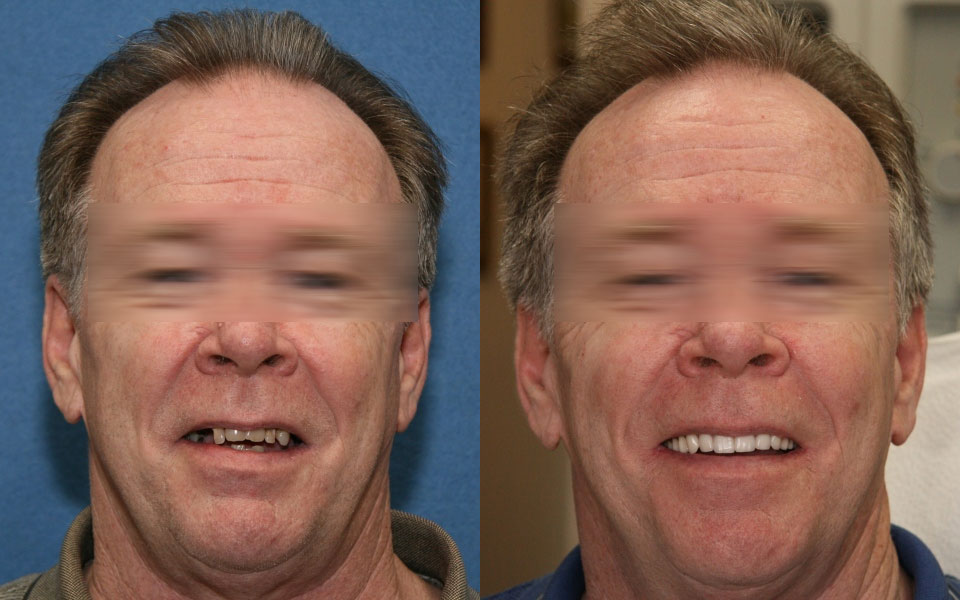
Unfortunately, people are having many serious problems with dental implants in some cases. There are many dentists who are attempting complex implant cases without the full training required. And there is a lot of pressure on those dentists to try shortcuts in order to speed the treatment, or to save money. Here are some of the issues that come up.
Loose Dental Implants
Contents [show]
Unfortunately, there is a lot of dental implant failure that needs to be treated. A large portion of a periodontists dental practice is devoted to re-treating dental implant patients, re-doing work that had already been done once.
A loose dental implant can be from several possible causes.
- The bone around the implant doesn’t fill in and bond to the implant.
- Infection around the implant.
- There wasn’t enough quality bone around the implant.
- It heals properly, but later becomes infected. Periimplantitis.
- Something can break – the implant, the implant screw, the crown on the implant.
- Broken restorations can be repaired. But a fractured implant will need to be removed.
Dental Implant Fell Out
If the looseness continues, eventually you can have the dental implant fall out. These situations can be treated, but it will require a new fixture and new surgery. Sometimes bone grafting may be required.
Question: My dental implant fell out. It got loose after a couple of years, and finally it just fell out. What would cause this and what can be done?
Answer: There are several possible reasons that a dental implant would fall out:
- When it was initially placed, the bone where it was placed may not have been high enough quality. If the implant isn’t anchored in solid bone, over time it can work itself loose and eventually fall out.
- Infection is a major problem. If any parts of the dental implant become loose to where they allow debris to get lodged, that debris will become a nidus of infection which will cause the bone support to be weakened to where the fixture eventually can just come out.
- Poor quality fixtures, or non-custom abutments can compress or stretch the tissue, causing tissue inflammation and eventual rejection of the fixture by the body.
- Some people simply have biological issues that make them prone to rejecting implants. Whenever you’re dealing with the human body, there are issues beyond the control of the dentist that can cause dental implant failure.
What can be done about a dental implant that falls out?
A new dental implant will need to be placed. Depending on what happened and whether it is being used to anchor a denture or a single tooth, it may need to be placed in a different site in the mouth or in a slightly different position. If necessary it can be placed in the same position, but there will need to be some time for healing. It may require bone grafting. Generally speaking, this is a problem that can be fixed, however.
Improper Dental Implant Placement
One of the errors made by inexperienced or inadequately trained implant dentists is the improper placement of the dental implants. We see this too often in cases that come through our door. Here is an example of a patient who came to us complaining of shooting pains in her jaw. First, here is the radiograph in sagittal (side) view:
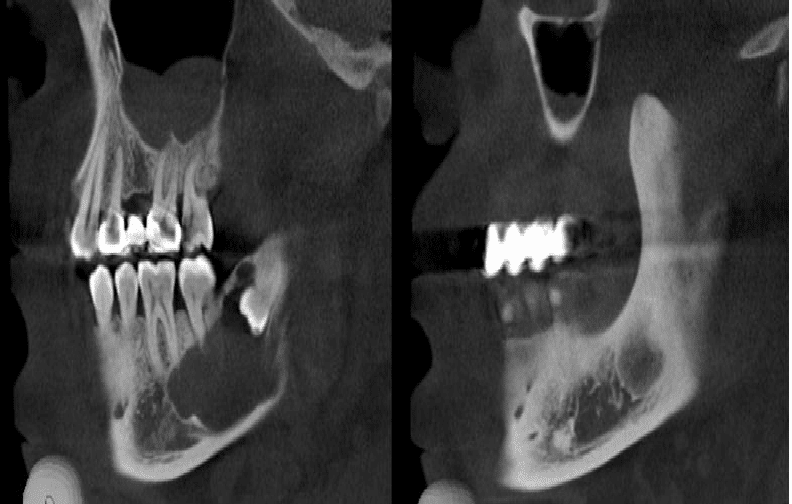
The darker space between the arrows is the nerve canal that runs through the lower jaw. Notice how it is relatively narrow and of a uniform width further back in her jaw, and when it gets close to the implant, it becomes considerably wider. This is because the surgeon, possibly from a lack of experience, may have thought that avoiding direct impingement on the nerve was good enough. But if there is less than two millimeters of bone between the implant and the nerve canal, it can cause inflammation, as indicated by the widening of the canal in this scan.
Further diagnostic information was needed, however, before undertaking surgical intervention. He ordered an MRI of the lower jaw, and had it evaluated by his radiology partner. Here is the MRI:
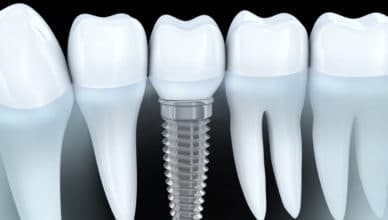
This MRI image shows that the nerve canal is expanded, and the doctor has indicated on the image the inflammation detected within the nerve canal. Imagine if you bruised your arm. It would turn red and swell at the point of the bruise. The same thing has happened here to the nerve, causing pain.
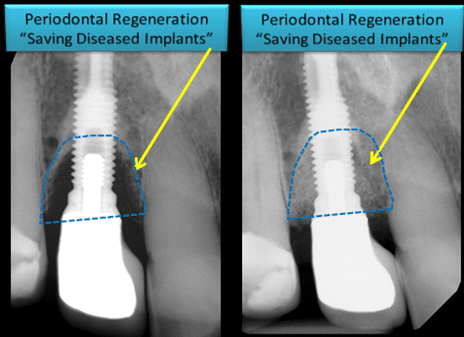
Doctor also ordered a CAT scan. Here is a cross-sectional frontal view, taken from the three-dimensional CAT scan:
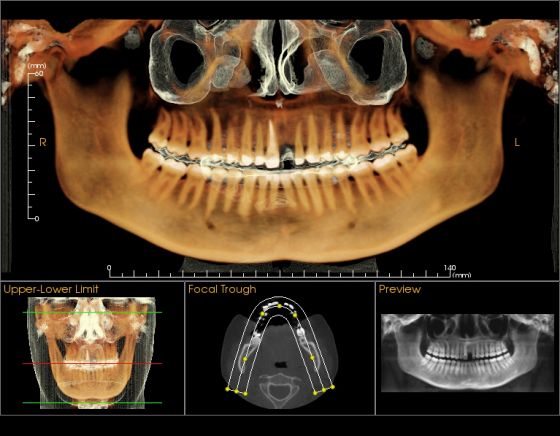
These images are cross-sectional images taken at one-millimeter slices of the lower jaw. You can see the dark circle in the jawbone below the implant- that is the nerve canal. There are only about 1.5 millimeters of bone between the implant and the nerve canal, as indicated by the red arrow. This is in the risky zone where the patient can experience nerve inflammation. And she was indeed complaining of sharp, lancing pain on this side of her jaw. 2 to 3 millimeters of bone is desirable to provide an adequate safety zone in order to avoid this problem.
Another problem is indicated by the yellow arrow, and that is inadequate bony support. Note than only about a third of the implant is solidly encased in bone. This implant is approximately 12 millimeters long, but, on the right side of the image, we show only 4 millimeters supported by bone. Placement like this will cause a poor long-term prognosis for the stability of the implant.
A dental implant in this situation is susceptible to movement, which can loosen it and contribute to inflammation and infection. We call this inflammation around an implant “periimplantitis,” and it can eventually cause the loss of the implant.
The patient’s diagnostic records gave a consistent picture of serious inflammation caused by a violation of the safety zone between the implant and the nerve canal. The implant was surgically removed, and the pain disappeared.
Dental Implant Infection
One of the prime causes of dental implant failure is infection. Infection occurs at the site where the implant fixture attaches to the bone. It can be characterized by redness in the surrounding tissue, soreness, looseness, or an unpleasant taste or smell coming from the site. Dental implant infection results from several causes. There can be underlying health issues, inadequate healing time allowed, improper fit of the parts of the fixture, or just that the fixture becomes loose, allowing a pathway for infection. Some fixtures have been found penetrating sinus cavities.
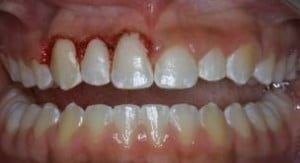
Causes of dental implant infection
There are several possible causes to be aware of:
- The crown on the dental implant can be over-sized, or can otherwise have an unhealthy contour. This seems like a simple matter, but if the crown presses too much on the tissue, it isn’t healthy and can lead to inflammation and then infection. Many dentists, in an attempt to contain the high costs of implant fixtures, will use “one-size-fits-all” abutments. This can save them several hundred dollars in costs, but it can also lead to this type of inflammation and infection that develops after the patient completes treatment. The doctor has each abutment custom-made to fit each individual patient.
- Sometimes there can be a slight infection right after the surgery, because of bacteria that enter the surgical site. If we are dealing with ordinary oral bacteria. this can often be resolved simply with antibiotics, and won’t pose any long-term risk. Some surgeons routinely administer antibiotics before and/or after the surgery to deal with this routine contamination.
- If substandard fixtures are used, because they may not have a precision fit, screws can become loose or gaps can occur, and these will attract bacteria. Because of the great difference in cost between substandard fixtures and precision-fitting ones, the temptation is great for dentists to cut costs here. But the long-term effects for the patient can be serious. For more information on this, please see our page on dental implant costs and quality.
- When you have a loose dental implant, there can often be infection around it. The primary problem, however, is that it is loose. Resolving the infection will not solve the fundamental problem. The implant may need to be replaced.
Treatment of dental implant infection
Many people have the idea that antibiotics alone can treat this. But without treating the cause of the infection, the use of antibiotics alone is often harmful, because they breed bacteria that are resistant to the antibiotic being used. The source of the infection needs to be eliminated.
So if the problem is a loose implant, or improperly fitting implant parts that are attracting bacteria, the offending fixtures need to be replaced. Once a fixture becomes mobile, removal is generally the only option for treatment. Sometimes, proper dental implant maintenance is all that is required. They need to be cleaned regularly, just as teeth need to be cleaned.

